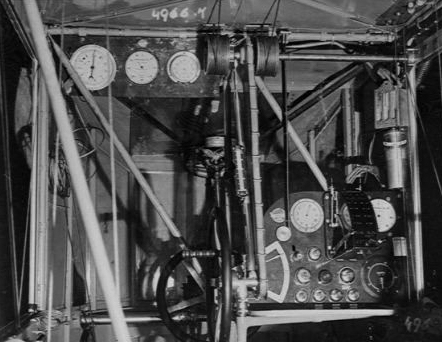
This is the airship’s central command station, with the elevator wheel in the centre and instrument panel on the right. Note the elevator position indicator to the right of the elevator wheel. It was important to know just how much elevator was being used as this could indicate whether the ship was light or heavy. Lots or ‘up’ elevator when the ship was flying at a constant altitude might indicate that a lot of dynamic (rather than static) lift was being used to prevent the ship from descending. If the ship then slowed down the dynamic effect would be lost and a heavy ship would lose altitude very rapidly and might not be able to recover in time. The can-like object hanging up on the right is the statoscope which indicated whether the ship is rising or falling. About that are manometers which showed the pressure in the envelope or ballonets. The steering coxswain’s helm can be seen at the very front. He steered the ship on headings given to him by the Captain, and the height coxswain maintained the correct height. The captain did not handle the ship himself – he issued the orders and the rest of the crew carried them out, as on a surface ship. Engine telegraphs were used to signal power requirements to the engineers in the power car.
Image and description kindly provided by Brian Turpin

 NS11 – As Bright As Day is very much a work in progress and has been made possible by the generous and enthusiastic support of many individuals and organisations. If you have any information, records or material relating to British NS Class airships we would be very interested to hear from you – especially anyone related to members of the crew of NS11 or any airship of the class during their service with the RNAS or RAF during and beyond WWI.
NS11 – As Bright As Day is very much a work in progress and has been made possible by the generous and enthusiastic support of many individuals and organisations. If you have any information, records or material relating to British NS Class airships we would be very interested to hear from you – especially anyone related to members of the crew of NS11 or any airship of the class during their service with the RNAS or RAF during and beyond WWI.
Latest